Elsewhere on this blog we’ve espoused the virtues of the Tinkyada brand GF pasta. In a word, it’s great. You can find all sorts of GF pastas these days, made from brown rice flour, quinoa flour, corn flour, and other base ingredients. It’ll be no surprise to our regular readers, though, that we think the best pasta is the fresh stuff made from scratch at home. Here, we’ll show you how we do it.
First, a note: here, we’ve made a fettuccine-style noodle and paired it with fresh mussels in a white wine broth, but you can just as easily use this recipe to make linguine, lasagna, and other forms of pasta. Now, for the details…
For the flour, use equal parts tapioca flour and brown rice flour, mixed well together. Add 1 1/2 tsp of xanthan gum to every two cups of flour. As a rough estimate for how much flour and egg to use, ballpark between 3/4 cup and 1 cup flour to 1 egg, per dinner serving. For example, since in this recipe we were making dinner for two people, we used a little under 2 cups of flour, and 2 eggs.
 Begin by forming your flour into a mound on the counter. Then, hollow out the center of the mound in order to make a “well.” Place your eggs into the well, and also add a generous dash of salt. Begin to work the eggs into the flour. I find it most effective to use the index and middle finger of one hand, swirling the egg and slowly pulling in dry flour from the perimeter.
Begin by forming your flour into a mound on the counter. Then, hollow out the center of the mound in order to make a “well.” Place your eggs into the well, and also add a generous dash of salt. Begin to work the eggs into the flour. I find it most effective to use the index and middle finger of one hand, swirling the egg and slowly pulling in dry flour from the perimeter.
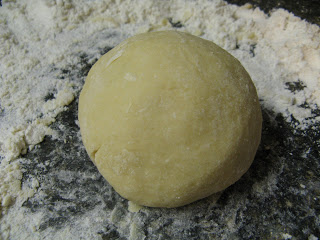 As the egg and flour incorporate, they’ll form into a beautiful dough. It should have a smooth texture, and you’ve added enough flour when the dough looses its tackiness.
As the egg and flour incorporate, they’ll form into a beautiful dough. It should have a smooth texture, and you’ve added enough flour when the dough looses its tackiness.
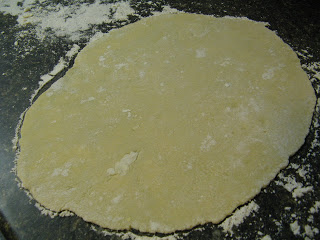 Make sure your counter is well floured (so the dough doesn’t stick), and using a rolling pin, roll out the dough ball into a broad, thin sheet.
Make sure your counter is well floured (so the dough doesn’t stick), and using a rolling pin, roll out the dough ball into a broad, thin sheet.
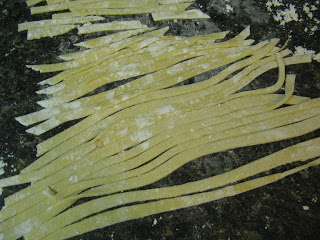 To cut the sheet of dough into pasta noodles, you can use a long chef’s knife or a pizza cutter. Do not use a hand-cranked or other pasta machine. The GF dough won’t cooperate the way a traditional pasta dough would. Let the noodles set on the counter for 5 or 10 minutes to firm up slightly.
To cut the sheet of dough into pasta noodles, you can use a long chef’s knife or a pizza cutter. Do not use a hand-cranked or other pasta machine. The GF dough won’t cooperate the way a traditional pasta dough would. Let the noodles set on the counter for 5 or 10 minutes to firm up slightly.
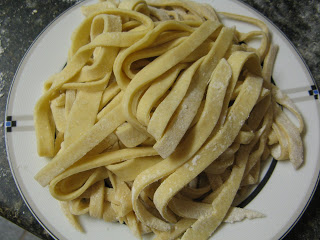 Once the noodles have set up, you can transfer them to a plate or bowl where they’ll be ready to cook.
Once the noodles have set up, you can transfer them to a plate or bowl where they’ll be ready to cook. 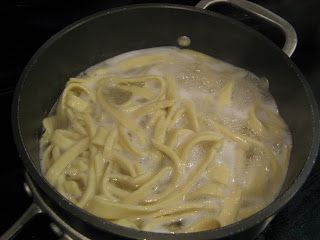 Because we’re dealing with fresh pasta, the cooking time is very brief. Usually, only three to five minutes (in boiling, salted water). In this instance, we made a thicker, wider noodle, so they cooked for closer to five minutes. A thinner, narrower noodle will take less time.
Because we’re dealing with fresh pasta, the cooking time is very brief. Usually, only three to five minutes (in boiling, salted water). In this instance, we made a thicker, wider noodle, so they cooked for closer to five minutes. A thinner, narrower noodle will take less time.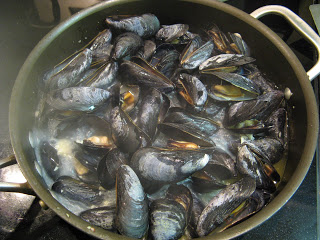 To make the fettuccine with mussels in a white wine broth, we first de-bearded and cleaned the mussels. In a pan, we sauteed several cloves of minced garlic in olive oil and butter. To that, add equal parts water and white wine, salt and pepper to taste, and the juice from half a lemon. Bring to a boil, add the mussels, and cover. The mussels should take about 5-7 minutes to cook. You don’t want to overcook or undercook mussels. Remember: if they don’t open naturally on their own during the cooking process, don’t eat them!
To make the fettuccine with mussels in a white wine broth, we first de-bearded and cleaned the mussels. In a pan, we sauteed several cloves of minced garlic in olive oil and butter. To that, add equal parts water and white wine, salt and pepper to taste, and the juice from half a lemon. Bring to a boil, add the mussels, and cover. The mussels should take about 5-7 minutes to cook. You don’t want to overcook or undercook mussels. Remember: if they don’t open naturally on their own during the cooking process, don’t eat them!
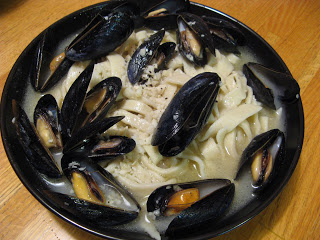 Lastly, strain your pasta and dish it out into a bowl. Add the mussels, and pour the white wine broth over the bowl. (For a more intense flavor, further reduce the broth over the stove top after you’ve removed the cooked mussels.) Enjoy!
Lastly, strain your pasta and dish it out into a bowl. Add the mussels, and pour the white wine broth over the bowl. (For a more intense flavor, further reduce the broth over the stove top after you’ve removed the cooked mussels.) Enjoy!
does it really take only 15 minutes to make the pasta? I would love to make my own pasta, but I am so scared to…Does it taste like boxed pasta? Does it taste any different?
It Taste a lot better then the boxed ……stuff
yes it is very easy to make it just be carefull cooking it it is easy to overcook
Hi SisterCooks,
The first time you make pasta from scratch, it will definitely take longer. But with practice, it becomes a quick and easy thing to do. The pasta tastes different than boxed pasta – homemade pasta is more tender, with a delicate flavor.
Cheers, Pete
Wow – I’m so impressed!!! 🙂 I am a
“Tinkyada Girl” but am intrigued at making my own pasta. Your fettuccine looks absolutely delicious!
Hi Maureen,
I share your enthusiasm for Tinkyada! But I encourage you to give the homemade pasta a try… it is indeed delicious!
Cheers, Pete
Nothing beats home made Pasta.
Yours looks just perfect.
Not so difficult either, more people should try it.
I always wanted to make homemade pasta when I could eat gluten (well, that was before I knew I shouldn’t eat gluten!). But now I can try this gluten free recipe and still make homemade pasta. I’m going to sock this one away for a cozy Sunday when I’m in the mood to tinker around!
H.Peter – Thanks for your note! You’re right…making homemade pasta isn’t nearly as intimidating or difficult as people often think it is.
GF Steve – Good luck making the pasta! Let me know how yours turns out! Kelli and I started making our own pasta during our gluten days, using a hand-crank Italian pasta machine from my mother. I’m glad to be able to carry on the tradition now that I’m gluten-free!
Cheers, Pete
Burgundy wine
(French: Bourgogne or Vin de Bourgogne) is wine made in the Burgundy region in eastern France.[1] The most famous wines produced here – those commonly referred to as Burgundies – are red wines made from Pinot Noir grapes or white wines made from Chardonnay grapes. Red and white wines are also made from other grape varieties, such as Gamay and Aligoté respectively. Small amounts of rosé and sparkling wine are also produced in the region. Chardonnay-dominated Chablis and Gamay-dominated Beaujolais are formally part of Burgundy wine region, but wines from those subregions are usually referred to by their own names rather than as “Burgundy wines”.
Burgundy has a higher number of Appellation d’origine contrôlées (AOCs) than any other French region, and is often seen as the most terroir-conscious of the French wine regions. The various Burgundy AOCs are classified from carefully delineated Grand Cru vineyards down to more non-specific regional appellations. The practice of delineating vineyards by their terroir in Burgundy go back to Medieval times, when various monasteries played a key role in developing the Burgundy wine industry. The appellations of Burgundy (not including Chablis).
Overview in the middle, the southern part to the left, and the northern part to the right. The Burgundy region runs from Auxerre in the north down to Mâcon in the south, or down to Lyon if the Beaujolais area is included as part of Burgundy. Chablis, a white wine made from Chardonnay grapes, is produced in the area around Auxerre. Other smaller appellations near to Chablis include Irancy, which produces red wines and Saint-Bris, which produces white wines from Sauvignon Blanc. Some way south of Chablis is the Côte d’Or, where Burgundy’s most famous and most expensive wines originate, and where all Grand Cru vineyards of Burgundy (except for Chablis Grand Cru) are situated. The Côte d’Or itself is split into two parts: the Côte de Nuits which starts just south of Dijon and runs till Corgoloin, a few kilometers south of the town of Nuits-Saint-Georges, and the Côte de Beaune which starts at Ladoix and ends at Dezize-les-Maranges. The wine-growing part of this area in the heart of Burgundy is just 40 kilometres (25 mi) long, and in most places less than 2 kilometres (1.2 mi) wide. The area is made up of tiny villages surrounded by a combination of flat and sloped vineyards on the eastern side of a hilly region, providing some rain and weather shelter from the prevailing westerly winds. T
he best wines – from “Grand Cru” vineyards – of this region are usually grown from the middle and higher part of the slopes, where the vineyards have the most exposure to sunshine and the best drainage, while the “Premier Cru” come from a little less favourably exposed slopes. The relatively ordinary “Village” wines are produced from the flat territory nearer the villages. The Côte de Nuits contains 24 out of the 25 red Grand Cru appellations in Burgundy, while all of the region’s white Grand Crus are located in the Côte de Beaune. This is explained by the presence of different soils, which favour Pinot Noir and Chardonnay respectively. Further south is the Côte Chalonnaise, where again a mix of mostly red and white wines are produced, although the appellations found here such as Mercurey, Rully and Givry are less well known than their counterparts in the Côte d’Or. Below the Côte Chalonnaise is the Mâconnais region, known for producing large quantities of easy-drinking and more affordable white wine. Further south again is the Beaujolais region, famous for fruity red wines made from Gamay. Burgundy experiences a continental climate characterized by very cold winters and hot summers. The weather is very unpredictable with rains, hail, and frost all possible around harvest time. Because of this climate, there is a lot of variation between vintages from Burgundy.
You can find more info at: http://www.burgundywinevarieties.com/
How much pasta does this recipe make?
Hi Amanda… as I mention in the post, I usually ballpark a ratio of 1 cup flour and 1 egg per serving. So, I double that for two people, quadruple it for four, etc. I’ve never measured exactly how much pasta it makes…I simply estimate that it makes about one serving, and multiply accordingly. Of course, this in part depends on what type of pasta you’re making (linguine? ravioli? lasagna?), and how robust your meal is (just pasta and a little sauce? lots of veggies and meat?). Hope this helps…
Cheers, Pete
Thank you Pete. Sorry I didn’t read your post as thoroughly as I should have. I’m a bit of a skimmer when I read.
I’m in England, where it’s nigh on impossible to buy tapioca flour. Could I just use rice flour, or should I add garbonzo bean flour / cornflour / polenta / maize flour (those are the ones I have in my cupboard!)? Also, I have a pasta machine, but it doesn’t include gluten free recipes in the book – I assume this recipe will work for the machine as well?
Hi Gemma… You certainly don’t need to use tapioca flour/starch to make a great GF from scratch pasta dough. In fact, these days we use our Artisan GF Flour Blend, which is comprised of brown rice flour, sorghum flour, potato flour and starch, cornstarch, and xanthan gum. You could use straight rice flour, or a blend of flours. Personally, I’m not a fan of the bean flours for both taste and texture. As for using a pasta machine, I’ve passed my pasta dough through hand-crank pasta rollers, but I’ve never used a machine (especially ones that extrude rather than roll the dough…). If experimenting with a pasta machine, I’d lean toward making a dryer pasta dough so that it won’t stick to the rollers and/or the dies.
Cheers, Pete
i’ve made your recipe several times now and this is the only way i eat pasta now! thank you!
Hi Taylor… I’m so glad to hear you’ve enjoyed the pasta!
Cheers, Pete
Hi there. I want to try your pasta recipe, but with ‘Best of Egg’ liquid substitute instead of real eggs. Have you ever made pasta with an egg substitute and, if so, how was it? Before going to all the trouble, thought I’d see if I should instead try an egg-free recipe. Also, the GF flour mix in your cookbook calls for 2/3 C cornstarch; can you suggest a substitute for that? My husband is allergic to egg yolk and corn… Thanks in advance!
Arrowroot powder is an alternative thickening agent to wheat flour & cornstatch.
AP thickening power is twice that of wheat flour so an adjustment needs to be made in the amount. AP may also be called Arrowroot flour.
(I love your book btw!) I’ve actually made a nice dish with simply sorghum, eggs, water, oil and a pinch of salt. I don’t like the taste of any of the gums and generally use whey instead, but I’ve never put any in the pasta. Is there a reason why you need xanthan gum?
Hi Anonymous… Glad you like the cookbook! We use xanthan gum for texture in the pasta dough. What kind of flavor and consistency do you get using only sorghum compared to a GF flour blend?
Cheers, Pete
Hi Suzanne… In this recipe, substituting for the egg would probably affect taste more than texture and performance of the dough, so I think you’ll be good there. For the cornstarch, you can use arrowroot instead (use a little less arrowroot than you would cornstarch…).
Cheers, Pete
Can GF pasta be dried and stored for later use?
Hi Anonymous… Typically, extruded pasta (the kind you buy at the supermarket from brands such as Tinkyada or Schar) are the ones that are dried and stored for later use. Fresh pasta is meant to be used pretty much right away.
Cheers, Pete
Hi,
I have a daughter who is wheat intolerant and a son who is rice intolerant. Any idea’s for a pasta that doesn’t use rice flour?
Thanks! Amber
Hi Amber… Any all-purpose GF flour blend should do the trick for making pasta from scratch, so choose a blend, such as Bob’s Red Mill’s GF All Purpose Flour Blend, that doesn’t include rice. You’ll be good to go!
Cheers, Pete
Hi! This sounds awesome! I cant wait to try it out! what type of flour did you use? Because I know you have your own mix, but that already has xanthan gum in it, for pasta do you add more? what does it do exactly?
thanks!
Emma
Hi Emma… We use our Artisan GF Flour Blend to make the flour, though most any all-purpose GF flour blend will do. I usually add some supplemental extra xanthan gum, but you can probably get away without it for pasta dough. (Search “xanthan gum” on our blog for a post about what it does in GF baking…) Enjoy!
Cheers, Pete
Hi, have you tried freezing some for later? Would that work out? I’m thinking I could dust the fresh noodles with extra flour so they won’t stick, wrap them in wax paper or plain paper, and then store the bundle in plastic bags in the freezer. I’m going to try this this week!
Hi Anonymous… We personally haven’t frozen the pasta for later use. We always use it fresh. But please do report back and let us know how it works out for you!
Cheers, Pete
Hi, Pete. In reference to drying the gluten free pasta, I know my Italian mother in law used to make homemade pasta (cavatelli, linguini) let it sit on the counter for several hours,flour it well, place it in a shirtbox and store in a dry place for up to three weeks–she checked it regularly during that time. This was made, of course with regular gluten flour, so I am not sure how GF pasta would act. I am very happy to have found your site as I am gluten sensitive. While I like the Tinkyada brand I have really had a craving for homemade pasta! I am going to try this tomorrow! Thanks!
Hi Anonymous… Thanks for your comment, and sharing that anecdote about keeping fresh pasta. I can tell you from experience that, at the very least, the pasta keeps well overnight. I made a fettucine/linguine style noodles, let them dry partially on the kitchen table, then dusted them lightly with GF flour to prevent sticking before placing all the noodles into a glass container and storing in the fridge. Boiled the next night they were great.
Cheers, Pete
Hi, looking forward to making this, but i would like to know what the calories are per serving. Can you let me know? Thanks in advance 🙂
Hi Kiki… We don’t calculate calories for our recipes, but you could plug the ingredients and # servings into any number of online recipe calculators to figure out the stats.
Cheers, Pete
What does one do if they can’t have eggs ?
Thanks
What do you use if you can’t eat eggs ?
Hi Digger… You have a variety of options for egg-free pasta. Some folks use water (and sometimes a touch of olive oil). Some also add a touch of ground flax (mixed in water). Or Ener-g egg replacer. Try searching the internet for “egg-free fresh pasta” or “fresh vegan pasta” and you’ll turn up plenty of examples.
Cheers, Pete
For lasagna, can you dry these noodles or do you use them fresh? If fresh, how does that affect the other ingredients you use and how long you cook it. Thanks,
P.S. sorry if this posts twice, I refreshed the post but still didn’t see my comment.
Hi R Mom… For lasagna, we always use the noodles fresh. Because they’re fresh, they don’t need to be pre-boiled before assembling the lasagna, the way you might with pre-made store-bought lasagna noodles. Just assemble layers of sauce and cheese, and their inherent moisture is enough to cook the noodles. The cooking time is similar. When the lasagna is heated through, and the top cooked/browned to your liking, it’s pretty much done. You can always cover with tinfoil and cook for longer if needed for the center of the lasagna to come up to temperature.
You could also try drying out the noodles, though we’ve never done that with lasagna. It has worked well for us with other noodles, however.
Cheers, Pete
Could the pasta be made only with the brown rice flour? We do not eat most grains, except for the some brown rice and beans once in a while, but my 8 years old misses pasta, so I’m looking for an alternative. Could the tapioca flour be substitute with flaxseed, perhaps? Jessica.
Hi J Gotay… Yes, the pasta could be made with any number of gluten-free flours. These days, we use our Artisan Gluten-Free Flour Blend. The recipe, and ingredient substitutions, are here:
http://noglutennoproblem.blogspot.com/2010/04/artisan-gluten-free-flour-blend.html
You could use brown rice flour plus cornstarch, potato starch, arrowroot flour, or another starch to complement the whole grain rice.
Cheers, Pete
Hello! I just wanted to share that I made your recipe today and loved how this pasta came out! This was my first time ever making pasta. Well, I did have to tweak it a little because some reason the eggs never turned the flour into dough, just dry powder, so I added another egg and a drizzle of olive oil and threw it in my mixer. It finally became moist and I was able to roll it out (mine seemed like a tough dough) but it worked in the end. I loved how pliable the pasta strips are. I’ll be sharing about this in a post soon but here’s a peek at what I made tonight with it: http://mommyimhungry.blogspot.com/
The flours here used are pretty much starchy ones and being a low carb those don’t work for me however , you did answer a question I had about using xanathan ratio to flours. I’m hoping this will work with almond flour alone.should I up this ratio because of the lack of starch?
Thanks for the pasta recipe 🙂
Iv made it twice now, it works so well. I do find I need to put more egg in, perhaps eggs are smaller in South Africa. Haha
You make it look so easy! I am encouraged to try it.